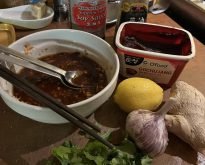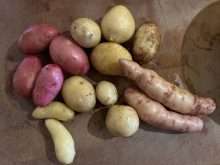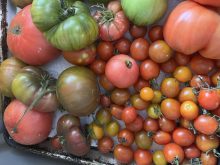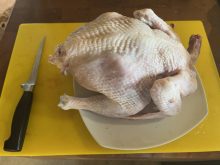During hot days, my cooking tolerance plummets. Last thing I want is anything warm — food, air, oven, stovetop flame. My appetite plummets too. A handful of small ripe tomatoes from my garden and a slice of buttered sourdough toast make the ideal hot weather walkabout lunch.
My gardening situation is a little out of the ordinary, because our actual in-the-ground garden (that had been tended by my grandmother, then my mother) was covered with a berm to protect our old farmhouse in the wake of the flood of 2011 — you remember that flood, the latest “flood of the century.” Our acreage, lowest point in the neighbourhood, became a virtual island, and we were surrounded by acres of water that, at its worst, came within 20 feet of our house.
When we recovered our breath, the giant earthmovers arrived to create not only a causeway out of our 500-metre driveway, but also the aforementioned berm around the house. We lived beside the resulting “lake” for seven years. Thus, no garden bed anymore, and no likely spots within the berm or without where I could dig a new bed without more labour than I was willing to endure. Plus the quack grass, waiting to engulf any newly turned bed. I called it the quack grass conundrum. You know. So, my brother built raised beds for me. The tomato plants occupy one of them.
Read Also

Seasoning for Korea’s culinary wave
Not unlike K-pop, Korean cuisine has become part of the international cultural tidal wave called Hallyu, Saskatchewan chef and writer dee Hobsbawn-Smith says.
This spring, I didn’t start tomato seeds, but bought seedlings in a variety of heritage breeds, among them Sungold, Bonny Best, Wagner’s Blue-Green, Zena’s Gift, Chocolate Cherry, Principe Borghese, Roselle Purples and heritage beefsteak. In July, a hailstorm knocked the stuffing out of some plants, sending branches and blossoms flying. I adjusted my expectations accordingly.
Then the tomatoes started to set fruit and ripen. Some produced more flowers. Hopefully, I walked around the raised bed each day as I watered, assessing when I could start to pick. This year’s yield has been delicious, and last year’s heat dome that doomed my tomatoes to failure is now a faded memory.
Earliest off the stems were the Sungolds, as usual, those tangerine flavour bombs, handfuls of explosive tomato taste packed into a tiny globe. The first ones I harvested didn’t make it into the house — I’d walk in with my bowl full of basil and beans and Dave would say, “What? No ripe tomatoes yet?”
“I just grinned and shook my head. ‘No,’ was all I said,” as Canadian songwriter Robbie Robertson wrote in “The Weight.”
Well, the tomatoes are coming in now by the bowlful. Some I consign to the oven for my annual freezer-destined roasted tomato sauce festival. That sauce contributes to soup pots, bowls of pasta with Bolognese, chili, baked beans and whatever else comes to mind in midwinter. Some tomatoes we eat in salads of all sorts. Some I might dry. Others go into the oven to slump beside roasted peppers and carrots. Some of the smaller tomatoes still don’t make it past the kitchen door. Some are destined for salsa — fresh salsa, I mean, not its cooked and canned cousin — that I heap onto grilled slabs of sourdough bread for bruschetta, the messy knife-and-fork version of my early-season walking-around snack.
Tomato season is short, so we make the most of it. First we eat, then we make notes in our garden journals about which tomato varieties to plant next year.















